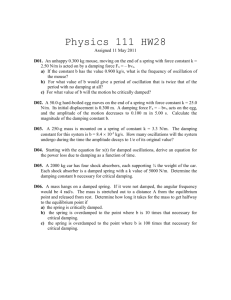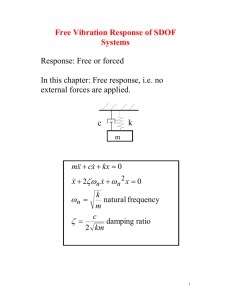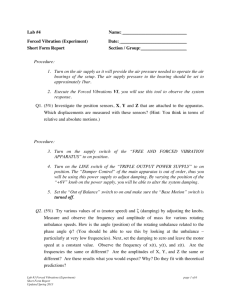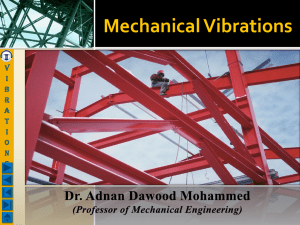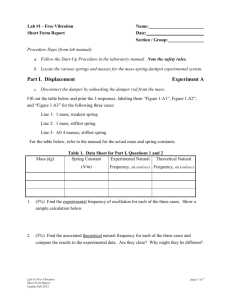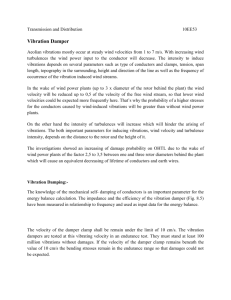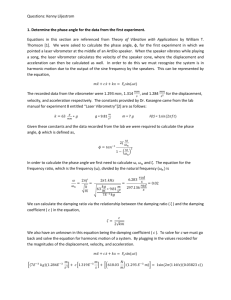3.b.Technical Quiz
advertisement
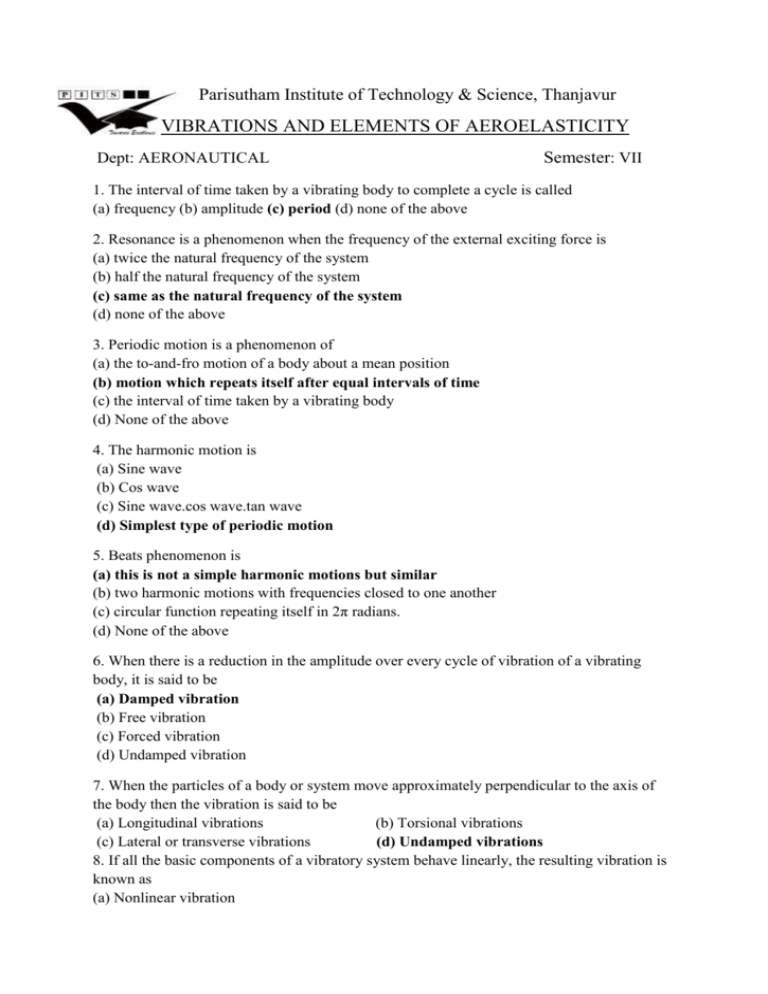
Parisutham Institute of Technology & Science, Thanjavur VIBRATIONS AND ELEMENTS OF AEROELASTICITY Dept: AERONAUTICAL Semester: VII 1. The interval of time taken by a vibrating body to complete a cycle is called (a) frequency (b) amplitude (c) period (d) none of the above 2. Resonance is a phenomenon when the frequency of the external exciting force is (a) twice the natural frequency of the system (b) half the natural frequency of the system (c) same as the natural frequency of the system (d) none of the above 3. Periodic motion is a phenomenon of (a) the to-and-fro motion of a body about a mean position (b) motion which repeats itself after equal intervals of time (c) the interval of time taken by a vibrating body (d) None of the above 4. The harmonic motion is (a) Sine wave (b) Cos wave (c) Sine wave.cos wave.tan wave (d) Simplest type of periodic motion 5. Beats phenomenon is (a) this is not a simple harmonic motions but similar (b) two harmonic motions with frequencies closed to one another (c) circular function repeating itself in 2π radians. (d) None of the above 6. When there is a reduction in the amplitude over every cycle of vibration of a vibrating body, it is said to be (a) Damped vibration (b) Free vibration (c) Forced vibration (d) Undamped vibration 7. When the particles of a body or system move approximately perpendicular to the axis of the body then the vibration is said to be (a) Longitudinal vibrations (b) Torsional vibrations (c) Lateral or transverse vibrations (d) Undamped vibrations 8. If all the basic components of a vibratory system behave linearly, the resulting vibration is known as (a) Nonlinear vibration (b) Deterministic vibration (c) Linear vibration (d) Random vibration 9. D’Alembert’s Principle can be used directly to derive the differential equations of motion for a dynamic system. (a) True (b) False (c) None of the above 10. A single-degree-of-freedom system has only one natural frequency. (a) True (b) False (c) None of the above 11. The real part of the solution to the characteristic equation for a single-degree-of-freedom system is zero. Which one of the following best describes the system? (a) Under damped (b) Unstable (c) Undamped (d) Non-periodic 12. The fundamental natural frequency of a system is a: (a) The largest value (b) The smallest value (c) Any value (d) None of the above 13. For an object undergoing simple harmonic motion, a. the amplitudes are usually regarded as being large b. the acceleration is greatest when the displacement is greatest. c. the acceleration is greatest when the speed is greatest. d. the maximum potential energy is larger than the maximum kinetic energy. 14. If both the mass m of a simple pendulum and its length L are doubled, the period will a. increase by a factor of 1.4 b. increase by a factor of 2. c. increase by a factor of 0.71. d. be unchanged. 15. Consider a spring-mass system whose motion is governed by the oscillatory equation d2x/dt2 + cx = 0. What is its angular frequency of oscillation? (a)c (b)√c (c)c2 (d)c/m (e)c/2 16. What modeling method/s apply for determining the system equations of motion when viscous damping is present in a system? a. Lagrange’s Equations b. Newton’s Law c. The Energy Method d. The Fourier method 17. The settling time of a system can be changed by modifying. . . a. m b. c c. k d. η 19. Coulomb damping a. works best at resonance b. works worst at resonance c. is a precise model of friction damping d. is equivalent to (the same as) viscous damping 18. Correct units for the viscous damping coefficient are: (a) kg s (b) kg/s (c) N s/m (d) N m 19. The amplitude of acceleration of a vibrating system is given as 2 g. The units of g may then be (a) m/s (b) ft/s2 (c) grams (d) lbs/slug 20. The natural frequency of a system is a function of (a) the spring-mass system (b) mass of the system (c) stiffness of the spring (d) none of the above 21. In the spring-mass system, if the mass of the system is doubled with spring stiffness halved, the natural frequency of vibration (a) remains unchanged (b) is doubled (c) is halved (d) is quadrupled 22. In the spring-mass system, the mass ‘m’ and spring stiffness ‘k’ is taken to very high altitude, the natural frequency of vibrations (a) remains unchanged (b) increases (c) decreases (d) none of the above 23. In a cantilever beam with load acting at the end point, the spring stiffness is given by, (a) k = 3EI / L3 N/mm (b) k = 48EI / L3 N/mm (c) k = L3 / 3EI N/mm (d) k = L3/ 48EI N/mm 24. The degrees of freedom of a simple pendulum is given by (a) 2 (b) 6 (c) 0 (d) 1 25. The damping force is constant in magnitude but opposite in direction to that of motion of vibrating bodies in case of (a) viscous damping (b) coulomb damping (c) structural damping (d) slip damping 26. In case of critical damping, the damping factor ‘ξ’ value is (a) ξ = 0 (b) ξ < 1 (c) ξ >1 (d) ξ = 1 30. The general nature of damped free oscillations whose amplitude decreases with time is (a) no damping system (b) underdamped system (c) critical damped system (d) overdamped system 27. The natural logarthmic of ratio of any two successive ampltiudes on the same side of the mean line is known as (a) damping factor (b) critical damping coeffcient (c) logarithmic decrement (d) overdamping system 28. The characteristics of underdamped system of motions are (a) amplitude increases with time (b) amplitude decreases with time (c) amplitude is constant with time (d) none of the above 29. The damped natural frequency in case of underdamped system is given by the equation (a) ωd / ωn = 1 – ξ2 (b) ωd = ωn √1 – ξ2 (c) ωd = ωn √1 – ξ (d) ωd = √1 – ξ2 1. In a damped vibration system, the damping force is proportional to (a) displacement (b) velocity (c) acceleration (d) jerk 30. Critical damping is a function of (a) mass and stiffness (b) mass and damping coeffcient (c) stiffness and natural frequency (d) natural frequency and damping coeffcient 31. In a vibration isolation system, the transmissibility will be less than unity for all values of damping factors, if the ratio of forcing frequency to natural frequency is (a) equal to 1 (b) less than √2 (c) more than √2 (d) less than 1 32. With viscous damping, the ratio of frequency of damped oscillations to frequency of undamped oscillations is (a) less than unity (b) more than unity (c) equal to unity (d) equal to 2 33. The bifilar suspension system is used to determine (a) natural frequency of vibrations (b) position of balancing weights (c) moment of inertia (d) centripetal acceleration 34. When there is a reduction in the amplitude over every cycle of vibration of a vibrating body, it is said to be (a) Damped vibration (b) Free vibration (c) Forced vibration (d) Undamped vibration 35. For a vibrating body under steady state forced vibrations, if ratio of forcing frequency to natural frequency is very high, then phase angle would tend to approach (a) 0 o (b) 90 o (c) 180 o (d) 270o 36. Forced vibrations (a) are followed by free vibrations (b) are preceded by free vibrations (c) takes place at frequency more than natural frequency (d) are independent of natural frequency 37. The stretched spring of a guitar when operated is subjected to (a) Free vibrations (b) Forced torsional vibrations (c) Forced transverse vibrations (d) Damped vibrations 38. A vibrometer indicates (a) Vibration amplitude (c) Nature of vibrations (b) Vibration frequency (d) second and above harmonics only 39. The ratio of maximum displacement of the forced vibrations to the deflection due to the static force is called (a) Logarithmic decrement (b) Damping coefficient (c) Critical damping coefficient (d) Magnification factor 40. Which of the following instruments may be used in vibration measurements (a) photometer (b) accelerometer (c) dynamometer (d) velometer 41. If the damping factor for a vibrating system is unity then the system is (a) Critically damped (b) Undamped (c) Under damped (d) Over damped 42. A vibrating beam has following degrees of freedom (a) Zero (b) 1 (c) 2 (d) 3 43. The minimum amplitude of two waves of amplitude A1 and A2 resulting into beats is (a) A1 + A2 (b) A1 - A2 (c) 0.5 (A1 + A2) (d) 0.5 (A1 - A2) 44. In the S.I system of units, the units of frequency are (a) Cycles per second (b) Cycles per minute (c) Hertz (d) revolutions / min. 45. At resonance the natural frequency of the system is (a) equal to impressed frequency (b) less than the impressed frequency (c) more than the impressed frequency (d) half of the impressed frequency 46. In viscous damping the energy is dissipated in the form of (a) frictional energy (b) heat energy (c) viscous energy (d) kinetic energy 47. For the motion to be the non-oscillating type, the damping ratio should be (a) less than unity (b) equal to unity (c) greater than unity (d) infinitely large 48. In coulomb damping the resisting force (a) depends upon velocity (b) depends upon displacement (c) depends upon velocity and displacement (d) is independent of velocity and displacement 49. The damping ratio for a seismic instrument is in the range of (a) 0.3 to 0.4 (b) 0.4 to 0.5 (c) 0.5 to 0.6 (d) 0.6 to 0.7 50. Critical damping is a function of (a) mass and stiffness (b) mass and damping coefficient (c) stiffness and damping coefficient (d) stiffness amd frequency Staff signature H.O.D signature
